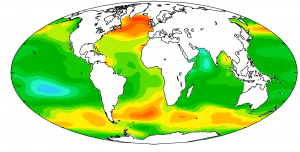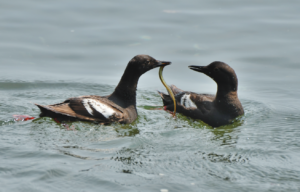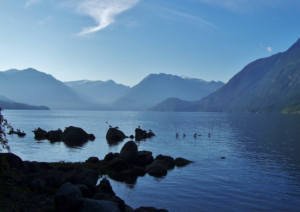 As I indicated in the last issue, several of this year’s climate-change articles will address the impacts of global warming on the Puget Sound region. (Other articles will focus on practical tips to reduce your personal carbon footprint or to make lifestyle changes to positively impact birds and other wildlife.) Here I want to focus on the problem of ocean acidification. Although many of climate change’s effects are caused by increased carbon dioxide, CO2, in the atmosphere, ocean acidification results from more CO2 dissolved in seawater. While we are sheltered from many of the worst effects of atmospheric CO2, we who live in the coastal Northwest will be especially hard-hit by changes in the acidity of the ocean.
As I indicated in the last issue, several of this year’s climate-change articles will address the impacts of global warming on the Puget Sound region. (Other articles will focus on practical tips to reduce your personal carbon footprint or to make lifestyle changes to positively impact birds and other wildlife.) Here I want to focus on the problem of ocean acidification. Although many of climate change’s effects are caused by increased carbon dioxide, CO2, in the atmosphere, ocean acidification results from more CO2 dissolved in seawater. While we are sheltered from many of the worst effects of atmospheric CO2, we who live in the coastal Northwest will be especially hard-hit by changes in the acidity of the ocean.
What is ocean acidification? Some portion of the CO2 in the atmosphere—25-30%—is absorbed by the ocean, lakes, etc. where it combines with water, H2O, to form carbonic acid: CO2 + H2O → H2CO3. Carbonic acidic is an acid by definition because it dissociates (comes apart) and releases hydrogen ions, H+: H2CO3 → HCO3– + H+. We use a 14-point scale called pH (from “power of Hydrogen”) to measure how acidic or basic a liquid is. A liquid with a pH of 7 is neutral, with equal concentrations of hydrogen and hydroxyl (OH–) ions. A pH of less than 7 is acidic and more than seven is basic; each number means 10 times as many hydrogen ions per liter as the next larger number; thus human blood, with a pH of 7.4, has 10 times as many hydrogen ions per liter as a pH of 8.4. Before the Industrial Revolution, the pH at the surface of the ocean was about 8.25 and had been so for many millions of years. Over the past 150 years, about 500 billion tons of CO2 has entered the oceans, and the average ocean surface pH has shifted to about 8.1; estimates are that it will drop to between 7.7 and 8.05 by the end of the century if we do not act to reduce atmospheric carbon levels. So although maritime waters remain basic, they are less so than they used to be. And, because our northwestern coastal waters experience atypically large amounts of upwelling—water from lower levels rising to the surface—the effect is magnified because deep sea water is already more acidic than surface water, due to decomposition of sinking organic matter.
What does this have to do with birds? Unfortunately, it ultimately harms them. The increased acidity disrupts the ability of many forms of sea life directly or indirectly important to birds (mussels, oysters, clams, some forms of plankton) to form shells. Marine organisms’ shells are made of calcium carbonate, CaCO3; however, as the pH falls and more hydrogen ions are present, the carbonate preferentially bonds with hydrogen ions to form carbonic acid, so less calcium carbonate is formed. The consequences of this altered chemistry can already be seen in the bleaching of the world’s coral reefs. Similarly, it is predicted that by the end of the century mussels and oysters will be able to grow only 75% and 90% as much shell, respectively, as they do today, making them more vulnerable to predation and requiring them to expend energy to constantly replenish their shells. Acidic conditions also greatly decrease the survival rates of shellfish larvae. Especially well-documented is the harm being done locally to the shells of pteropods, or sea butterflies. These small, free-swimming snails are major food sources for herring, mackerel, squid, and shrimp, which are in turn eaten by salmon, tuna, and walleye, and, of course, seabirds. Disruption low in the food chain works its way up to organisms on the top.
Many who are reluctant to act to reduce climate change rely on an economic argument: “It’s too expensive to reduce carbon emissions—it’s bad for business.” Fighting fire with fire, one could reply that increased ocean acidification has enormous economic consequences. In 2012, Washington determined that shellfish farming contributed $270 million to the state’s economy and provided more than 3,000 jobs. In addition, $1.7 billion dollars is generated annually by the commercial fishing industry in this state, which employs 42,000 Washingtonians. These jobs and that revenue stream will be imperiled if the ocean’s food chain became sufficiently disrupted. And to that can be added the $27 million contributed to the economies of coastal communities by recreational shellfish harvesting. In 2006 we began to experience massive oyster and scallop die-offs in the Northwest; this is reality, not a prediction. Although the situation has improved due to efforts to enhance local water pH and cleanliness, it is clear that the future of shellfish farming (and salmon and other fish harvests) depends upon carbon emission control. Reducing carbon emissions makes sense for the health of our environment, the wildlife we love, and for our wallets. (by Kim Adelson, photo – Wikimedia Commons)







